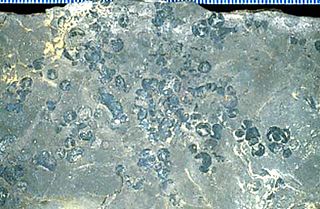Related Research Articles

The Devonian is a geologic period and system of the Paleozoic era during the Phanerozoic eon, spanning 60.3 million years from the end of the preceding Silurian period at 419.2 million years ago (Ma), to the beginning of the succeeding Carboniferous period at 358.9 Ma. It is named after Devon, South West England, where rocks from this period were first studied.

The Late Devonian extinction consisted of several extinction events in the Late Devonian Epoch, which collectively represent one of the five largest mass extinction events in the history of life on Earth. The term primarily refers to a major extinction, the Kellwasser event, also known as the Frasnian-Famennian extinction, which occurred around 372 million years ago, at the boundary between the Frasnian stage and the Famennian stage, the last stage in the Devonian Period. Overall, 19% of all families and 50% of all genera became extinct. A second mass extinction called the Hangenberg event, also known as the end-Devonian extinction, occurred 359 million years ago, bringing an end to the Famennian and Devonian, as the world transitioned into the Carboniferous Period.

Protosalvinia is a prehistoric plant found commonly in shale from shoreline habitats of the Upper Devonian period. The name Protosalvinia is a misnomer. The name literally means early Salvinia, and was given in the erroneous belief that the fossils were an earlier form of the living aquatic fern Salvinia. It is no longer believed that the fossils come from a fern, but deciding exactly what the fossils represent is still a matter of debate.
The Famennian is the later of two faunal stages in the Late Devonian epoch. The most recent estimate for its duration is that it lasted from around 371.1 to 359.3 million years ago. An earlier 2012 estimate, still used by the International Commission on Stratigraphy, is that it lasted from 372.2 million years ago to 358.9 million years ago. It was preceded by the Frasnian stage and followed by the Tournaisian stage.
The Hangenberg event, also known as the Hangenberg crisis or end-Devonian extinction, is a mass extinction that occurred at the end of the Famennian stage, the last stage in the Devonian Period. It is usually considered the second-largest extinction in the Devonian Period, having occurred approximately 13 million years after the Late Devonian mass extinction at the Frasnian-Famennian boundary. The event is named after the Hangenberg Shale, which is part of a sequence that straddles the Devonian-Carboniferous boundary in the Rhenish Massif of Germany.
The Exshaw Formation is a stratigraphic unit in the Western Canada Sedimentary Basin. It takes the name from the hamlet of Exshaw, Alberta in the Canadian Rockies, and was first described from outcrops on the banks of Jura Creek north of Exshaw by P.S. Warren in 1937. The formation is of Late Devonian to Early Mississippian age as determined by conodont biostratigraphy, and it straddles the Devonian-Carboniferous boundary.
Cryptolepis is an extinct genus of prehistoric sarcopterygian or lobe-finned fish.

The Palliser Formation is a stratigraphic unit of Late Devonian (Famennian) age in the Western Canada Sedimentary Basin. It is a thick sequence of limestone and dolomitic limestone that is present in the Canadian Rockies and foothills of western Alberta. Tall cliffs formed of the Palliser Formation can be seen throughout Banff and Jasper National Parks.
Aciculopoda is an extinct prawn which existed in what is now Oklahoma approximately 360 million years ago. It was described in 2010 on the basis of a single fossil from Oklahoma. The single species, Aciculopoda mapesi, was named by Rodney Feldmann and Carrie Schweitzer in honour of Royal Mapes, a paleontologist who discovered the type specimen. It is only the third unambiguous fossil decapod from before the Mesozoic.
The Percha Formation is a geologic formation in southern New Mexico. It preserves fossils dating back to the Famennian Age of the late Devonian period.
The Alexo Formation a stratigraphic unit of Late Devonian age. It is present on the western edge of the Western Canada Sedimentary Basin in the central Rocky Mountains and foothills of Alberta. The formation consists primarily of dolomite. It is locally fossiliferous and includes remains of marine animals such as brachiopods and conodonts.
Palmatolepis is an extinct conodont genus in the family Palmatolepidae. It was the most abundant genus of conodonts of the Late Devonian, disappearing during the Devonian/Carboniferous crisis.
Icriodus is an extinct conodont genus in the family Gnathodontidae.
Alternognathus is an extinct conodont genus in the family Elictognathidae. An extensive study on its population dynamics and lifespan has recently been published.
Conodonts are an extinct class of animals whose feeding apparatuses called teeth or elements are common microfossils found in strata dating from the Stage 10 of the Furongian, the fourth and final series of the Cambrian, to the Rhaetian stage of the Late Triassic. These elements can be used alternatively to or in correlation with other types of fossils in the subfield of the stratigraphy named biostratigraphy.
Ancyrodella is an extinct genus of conodonts from the Late Devonian.
Siphonodella is an extinct genus of conodonts.
Cryptotaxidae is an extinct family of conodonts in the order Ozarkodinida. It includes the extinct genus Cryptotaxis.
The Sassenach Formation is a stratigraphic unit of Late Devonian age. It is present on the western edge of the Western Canada Sedimentary Basin in the Rocky Mountains and foothills of Alberta. It consists primarily of mudstone, siltstone, and silty carbonate rocks, and was named for Mount Sassenach in Jasper National Park by D. J. McLaren and E. W. Mountjoy in 1962.
The Dasberg Event was a minor extinction event that occurred during the Famennian, the final stage of the Devonian period. It is often considered to be one of the events contributing to the Late Devonian extinction, which is believed by many palaeontologists to have been a protracted event that took place over millions of years.
References
- ↑ Devonian conodont apparatuses and their vicarious skeletal elements. G Klapper and GM Philip, Lethaia, Volume 4, Issue 4, pages 429–452, October 1971, doi:10.1111/j.1502-3931.1971.tb01865.x
- ↑ Acta Geologica Polonica, Volume 55, Pages 211-466. Museum Ziemi. 2005. p. 211.
Devonian conodonts (Cryptotaxis sp.) are so far known only from the Frasnian - middle Famennian in the Solimoes Basin, northwestern Brazil (Hunicken & al. 1988).
- "Multielement Conodont Species from the Louisiana Limestone (Upper Devonian) of West-Central Illinois and Northeastern Missouri, U.S.A.", Karl M. Chauffe and Patricia A. Nichols, Micropaleontology, Vol. 41, No. 2 (Summer, 1995), pages 171–186, doi : 10.2307/1485950.